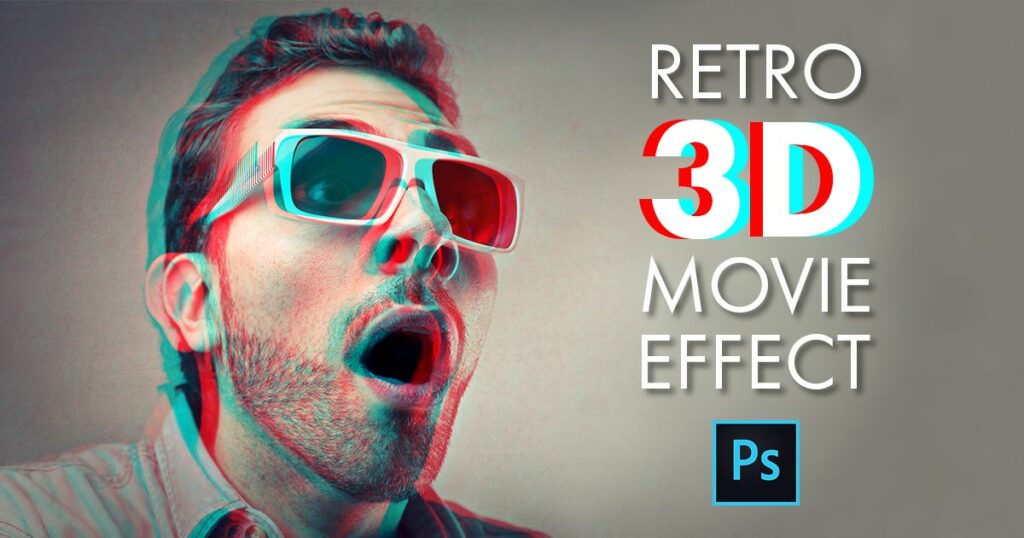Nostalgia Unleashed: A Comprehensive Guide to Creating a Retro 3D Movie Effect in Photoshop

Introduction:
The allure of retro aesthetics and the nostalgic charm of vintage 3D movies have inspired a resurgence in design trends. Adobe Photoshop, a powerhouse in digital image manipulation, offers creative minds the tools to transport their creations back in time. In this extensive guide, we will explore step-by-step instructions, creative insights, and advanced techniques on how to breathe life into your images by creating a Retro 3D Movie Effect. Whether you’re a seasoned graphic designer or an enthusiast eager to infuse a touch of cinematic nostalgia into your work, this guide will equip you with the skills to master this visually captivating technique.
Chapter 1: Embracing the Retro 3D Movie Aesthetic
1.1. The Allure of Retro Aesthetics: – Before diving into the technique, we’ll explore the timeless appeal of retro aesthetics. From the color palettes to the distinctive typography, we’ll delve into the elements that make retro design an enduring source of inspiration.
1.2. Reviving 3D Movie Magic: – Vintage 3D movies hold a special place in cinematic history. We’ll discuss the unique characteristics of retro 3D movie effects, from the iconic red and blue glasses to the distinctive depth and visual impact that defined this cinematic era.
Chapter 2: Understanding the Basics of 3D Effects in Photoshop
2.1. Introduction to Photoshop’s 3D Capabilities: – Photoshop’s 3D capabilities serve as the foundation for creating the retro effect. We’ll provide an overview of the essential tools and features that will be employed to bring a sense of depth and dimensionality to your images.
2.2. The Importance of Layer Styles: – Layer styles play a pivotal role in achieving a convincing 3D effect. We’ll delve into the significance of layer styles in creating depth, adding textures, and enhancing the overall retro ambiance of your composition.
Chapter 3: Selecting the Right Image for the Retro Treatment
3.1. Choosing the Ideal Image: – The success of the retro 3D movie effect hinges on selecting the right image. We’ll discuss considerations for choosing images that align with the nostalgic theme, exploring various genres and subject matters that lend themselves well to this technique.
3.2. Preparing the Image for 3D Conversion: – Preparing your image involves optimizing it for the 3D treatment. We’ll guide you through the process of adjusting color tones, enhancing contrast, and ensuring that your chosen image is primed for the retro transformation.
Chapter 4: Converting 2D to 3D in Photoshop
4.1. Creating a 3D Postcard: – The 3D postcard feature in Photoshop serves as the starting point for your retro journey. We’ll provide step-by-step instructions on how to convert a 2D image into a 3D postcard, exploring the nuances of adjusting depth and perspective.
4.2. Manipulating 3D Meshes: – Customizing the 3D mesh is key to achieving a tailored retro effect. We’ll delve into the intricacies of manipulating 3D meshes, adjusting angles, and fine-tuning the overall three-dimensional appearance of your image.
Chapter 5: Crafting the Iconic Red and Blue Anaglyph Effect
5.1. Applying Color Separation: – The hallmark of retro 3D movie effects lies in the distinctive red and blue color separation. We’ll guide you through the process of applying this classic anaglyph effect, exploring layer adjustments and achieving a visually striking color separation.
5.2. Fine-Tuning Color Channels: – Achieving the perfect balance in color channels is crucial for an authentic anaglyph effect. We’ll discuss how to fine-tune the red and blue channels, ensuring that each element in your composition contributes to the overall retro aesthetic.
Chapter 6: Enhancing Depth with Layer Styles
6.1. Utilizing Layer Styles for Depth Enhancement: – Layer styles play a dual role in the retro 3D movie effect by enhancing depth and texture. We’ll explore the application of layer styles, including bevels and embossing, to elevate the sense of dimensionality in your composition.
6.2. Experimenting with Opacity and Blending Modes: – Opacity and blending modes offer creative control over the interplay of elements in your retro 3D composition. We’ll delve into techniques for experimenting with opacity and blending modes to achieve captivating visual effects and atmosphere.
Chapter 7: Adding Texture and Grain for Vintage Realism
7.1. Infusing Retro Texture: – Vintage realism hinges on the infusion of texture into your composition. We’ll guide you through the process of adding retro textures to your image, creating an aged and authentic appearance that resonates with the charm of yesteryears.
7.2. Integrating Grain for Cinematic Appeal: – Grain contributes to the cinematic appeal of retro 3D movies. We’ll explore methods for integrating grain into your composition, simulating the texture of film and enhancing the overall vintage ambiance of your image.
Chapter 8: Creative Typography for Cinematic Impact
8.1. Typography in Retro 3D Movie Posters: – Retro 3D movie posters are often characterized by distinctive typography. We’ll discuss creative typography choices that align with the cinematic theme, exploring fonts, styles, and layouts that enhance the overall impact of your composition.
8.2. Placing Text in 3D Space: – Placing text within the 3D space of your composition adds an extra layer of depth and realism. We’ll provide step-by-step instructions on how to integrate text seamlessly into your retro 3D scene, ensuring it becomes an integral part of the cinematic narrative.
Chapter 9: Adding Dynamic Lighting Effects
9.1. Simulating Cinematic Lighting: – Cinematic lighting is pivotal in creating a realistic and immersive atmosphere. We’ll explore techniques for simulating dynamic lighting effects within your retro 3D composition, adding depth, drama, and cinematic flair to your visual narrative.
9.2. Experimenting with Glow and Lens Flares: – Glow and lens flares evoke the cinematic magic of retro movies. We’ll guide you through the process of experimenting with glow and lens flare effects, enhancing the visual impact and creating a sense of awe in your composition.
Chapter 10: Fine-Tuning and Refining the Retro Effect
10.1. Iterative Adjustments for Perfection: – Achieving perfection in your retro 3D movie effect requires iterative adjustments. We’ll discuss strategies for fine-tuning elements such as color balance, contrast, and overall composition to ensure a visually stunning and cohesive result.
10.2. Navigating Common Challenges: – Common challenges may arise during the creation of your retro effect. We’ll troubleshoot issues such as alignment discrepancies, color irregularities, and other potential hurdles, providing solutions to navigate these challenges effectively.
Chapter 11: Exporting and Showcasing Your Retro Masterpiece
11.1. Exporting High-Quality Images: – Preserving the quality of your retro 3D masterpiece is crucial for showcasing its full impact. We’ll discuss best practices for exporting high-quality images, ensuring that your creation looks impeccable across various platforms and mediums.
11.2. Presenting Your Work: – Presentation matters when showcasing your retro 3D movie effect. We’ll explore creative ways to present your work, from digital platforms to print, ensuring that your composition captivates and resonates with its intended audience.
Chapter 12: Inspirational Showcase and Case Studies
12.1. Showcasing Retro 3D Movie Effect Masterpieces: – To inspire your creativity, we’ll showcase a curated selection of retro 3D movie effect masterpieces that exemplify the potential of this technique. Each showcase will highlight the diversity and creativity that can be achieved within the realm of retro-inspired design.
12.2. Behind-the-Scenes Artist Insights: – Gain insights into the creative process by delving into behind-the-scenes interviews with artists who specialize in crafting retro 3D movie effects. Learn about their inspirations, challenges, and tips for achieving visually stunning compositions that transport viewers to a bygone cinematic era.
Conclusion:
The retro 3D movie effect in Photoshop opens a portal to a cinematic past, where red and blue glasses transported audiences to immersive visual worlds. This comprehensive guide has equipped you with the knowledge and techniques needed to master this visually captivating technique, from the foundational principles of 3D manipulation to the finer details of typography, texture, and lighting. As you embark on your journey of retro-inspired design, may this guide serve as a constant companion, offering inspiration and guidance as you infuse the magic of vintage cinema into your visual creations. Here’s to the timeless allure of retro aesthetics and the boundless creativity that unfolds when nostalgia meets the canvas of digital design.






